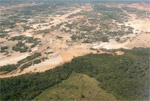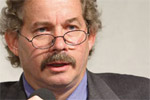Mongabay.com is partnering with the Skoll Foundation ahead of the Skoll World Forum on Social Entrepreneurship to bring a series of perspectives that aim to answer the question: how do we feed the world and still address the drivers of deforestation?
|
HOW DO WE FEED THE WORLD AND STILL ADDRESS THE DRIVERS OF DEFORESTATION? Soy, cattle, rice, palm oil, and logging are the principal drivers of deforestation. As global population increases from 7 billion to 9 billion by 2040, and as more and more people around the world rise out of poverty into the middle class, the demand for these commodities and practices will continue to rise with them. To address these issues, and in advance of the World Forests Summit hosted by the Economist in March, the Skoll World Forum on Social Entrepreneurship partnered with the Stanford Institute for the Environment and Mongabay News to surface the latest insights and innovations at the intersection of deforestation and sustainability. This debate will also set the stage for a larger discussion on deforestation at this year’s Skoll World Forum in Oxford, UK. |
I’m fortunate to travel the world helping conserve habitats for some of the world’s most iconic species. When I visit places like the Amazon and Sumatra, I’m still awestruck by their diversity and pristine beauty. I’m also reminded how threatened they are. Our growing demand for food and fiber is fueling deforestation in resource-rich regions of the world. As environmentalists, if we don’t change where and how we produce food and fiber, we can turn off the lights and go home. There won’t be any biodiversity left to protect.
Recently, I’ve been talking a lot about “agriculture sprawl.” According to the FAO, the expansion of the agricultural frontier is the main cause of deforestation, accounting for up to 90% of global deforestation each year. A closer look shows we currently use 33 percent of the Earth’s surface for food. About 25 percent can’t be used for production (mountains, deserts, cities, roads) and 12 percent is in National Parks, leaving about 30 percent of the planet. Over the past ten years we have expanded the global area used for food and fiber production by 0.6 percent per year. At this rate, after 40 years, we will have “eaten” nearly all the remaining natural habitat on the planet.

|
There is good news. Some of the world’s largest and most influential companies now understand how dependent their business is on a healthy planet. They are pursuing strategies to do more with less. They are working with partners across the value of chains of key commodities to intensify agriculture sustainably. As a result, they are driving new efficiencies and maintaining their lines of production while using less water, land and nutrients (to name a few), and reducing impacts such as GHG emissions, toxicity and water pollution.
We know that about 90 percent of deforestation is caused by agricultural expansion—in the Amazon, for instance, only the highest valued timber species are sold and the rest are burned. To reduce these impacts, many companies participate in global sustainability certification programs that establish performance standards across a number of variables, but always include habitat conversion and deforestation. The focus on performance instead of practice incentivizes innovation rather than just compliance. This has been key for companies to achieve better business and environmental performance.
On the forest products front, there has been considerable movement. We used about 380 million tons of pulp and paper globally in 2010. The data suggest that about half of that came from recycling paper rather than virgin stock. The Forest Stewardship Council, for its part, has certified some 8.4 of all wood produced globally.
 Jason Clay Senior Vice President, Market Transformation, World Wildlife Fund Jason Clay is WWF’s Senior Vice President of Market Transformation. Jason ran a family farm, taught at Harvard and Yale, worked at the U.S. Department of Agriculture and spent more than 25 years working with human rights and environmental organizations before joining WWF in 1999. |
“As environmentalists, if we don’t change where and how we produce food and fiber, we can turn off the lights and go home. There won’t be any biodiversity left to protect.”
Programs such as the FSC have changed the way commodities are produced for more than 15 years, but we need to accelerate these results. The newest performance-based standards are beginning to do just that. In just four years, 14 percent of global palm oil has been produced against the more performance based Roundtable on Sustainable Palm Oil standards. These programs are moving faster than organic production which has achieved less than 1% of global market share after some 40 years.
Some of the world’s major retailers and brands have decided that they can be more strategic and achieve bigger results by working together. For example, 18 companies in the Consumer Goods Forum (the CGF represents nearly 400 global retailers and brands with about $2.4 trillion in sales) publicly committed to take deforestation from their supply chains by 2020. They focused on four commodities (beef, soy, palm oil and pulp) from four countries (Brazil, Indonesia, Malaysia and Russia). This combination of commodities and producer countries represents more than 50% of deforestation globally. These companies are convinced that they not only can, but must meet increased demand without deforestation.
We know how to stop deforestation along the agricultural frontier. While the enlightened elements of the private sector work with the better producers, we must engage the worst performing 25 percent of producers which cause more than 50 percent of the impacts like deforestation, while producing less than 10 percent of the products. Government must step up to improve the bottom. Proving the business case for improved performance and market access will help governments make the tough choices needed. We have a lot of work to do. Companies, consumers, NGOs and government alike must hold producers to higher standards. The solutions are ready for the taking. If we don’t do this, fields and pastures will dominate every landscape rather than forests and plains. The choice is all of ours: agricultural sprawl or space for all?
To discuss this commentary, please visit Stemming Agricultural Sprawl
|
ALL POSTS IN THIS SERIES
Can we meet rising food demand and save forests? (04/03/2013) A few weeks ago the Skoll World Forum hosted an online debate on how increased global consumption can be balanced with sustainability. The debate asks how a rapidly growing world that is ever consuming can hope to feed everyone, and at the same time address the deforestation that is emitting massive amounts of carbon into the atmosphere and destroying the world’s greatest tropical forests. Many contributors made very strong points—even contradicting one another in their approaches and ideas. Strong ‘no deforestation’ commitments save forests and feed people (03/12/2013) As a global community, we have so far failed to answer this most pressing question; we have yet to build our cloud. Deforestation rates are down in some places, but overall, our forests continue to disappear much as they have for the past 50 years, driven principally by increasing global demand for food. Can we feed the world and save our forests? Yes, we can, and the solution lies in the global supply chain and the message some companies are now sending their suppliers: ‘If you cut down trees, I won’t buy your product.’ This has the power to silence bulldozers. It’s already doing so and now it’s time to go to scale. The need to jump-start REDD to save forests (03/08/2013) At least US$7.3 billion has been pledged for REDD+ over the period from 2008 to 2015, with $4.3 billion pledged for REDD+ readiness during the fast-start period alone (2010-2012). In addition to these funds, private investors, private foundations, and others have been channeling financial support to developing countries for REDD+ and related programs for several years now. A promising initiative to address deforestation in Brazil at the local level (03/05/2013) The history of the Brazilian Amazon has long been marked by deforestation and degradation. Until recently the situation has been considered out of control. Then, in 2004, the Brazilian government launched an ambitious program to combat deforestation. Public pressure—both national and international—was one of the reasons that motivated the government to act. Another reason was that in 2004, deforestation contributed to more than 55 percent of Brazil’s total greenhouse gas emissions, making Brazil the fourth-largest greenhouse gas emitter in the world. Saving forests by putting a price on them (03/04/2013) During the 2013 SuperBowl, the championship game of the US National Football League, a truck company aired an advertisement that likened farmers to God’s favorite assistant. It suggested that when God needs something tough, or gentle, done, he calls a farmer. The narration, taken from a speech given to the Future Farmers of America in 1978 by Paul Harvey, a radio host, plays directly to the near mythical stature of farmers and ranchers in American culture and their deep connection to nature. Saving forests by stemming agricultural sprawl (03/01/2013) I’m fortunate to travel the world helping conserve habitats for some of the world’s most iconic species. When I visit places like the Amazon and Sumatra, I’m still awestruck by their diversity and pristine beauty. I’m also reminded how threatened they are. Our growing demand for food and fiber is fueling deforestation in resource-rich regions of the world. As environmentalists, if we don’t change where and how we produce food and fiber, we can turn off the lights and go home. There won’t be any biodiversity left to protect. Can saving forests help feed the world? (02/28/2013) As world population climbs from 7 to a projected 9 billion people and emerging and developing economies demand ever more of the food and fiber that drive deforestation, many environmentalists ask with increasing urgency whether and how tropical forests can survive. But the question may actually be whether and how the world’s increasing, and increasingly rich, population can be fed unless tropical forests survive. The challenge of putting Brazil’s forests in good hands (02/28/2013) People often associate Brazil with its forests. It’s no wonder given that nearly 60% of the country’s territory is covered by forest and it holds about one-third of the world’s remaining tropical rainforests. You might assume that a country like this would care about educating people to sustainably manage this precious heritage. Well, you’d be wrong! The corporate conservation revolution (02/27/2013) There’s a new kind of environmental hero emerging. They don’t live in Washington, D.C., and they’re known more for their interest in increasing earnings than in reducing greenhouse gases. They are found in an unlikely place: The Corporate Boardroom, and they’re making a big difference in saving the worlds forests and our climate. In recent years, a group of visionary corporate leaders have been quietly teaming up with a growing number of environmental groups to take a hard look at what’s left of our planet’s natural resources. Together, they agree: we are past the point where our land and oceans can meet the food, energy and commodity demands of our planet’s seven billion inhabitants. |
Editor’s note: The opinions expressed in this op-ed do not necessarily reflect the views of Mongabay.com or its staff. Mongabay founder, president, and editor Rhett A. Butler served as an advisor to the Skoll Foundation from 2010-2012.
Related articles
Degraded lands hold promise in feeding 9 billion, while preserving forests
(03/29/2012) Making productive use of degraded lands and boosting productivity of small-holder farmers are key to meeting surging global consumption of agricultural products while preserving critical wildlife habitats, said an agricultural expert on the sidelines of the Skoll World Forum for Social Entrepreneurship in Oxford.
Corporations, conservation, and the green movement

(10/21/2010) The image of rainforests being torn down by giant bulldozers, felled by chainsaw-wielding loggers, and torched by large-scale developers has never been more poignant. Corporations have today replaced small-scale farmers as the prime drivers of deforestation, a shift that has critical implications for conservation. Until recently deforestation has been driven mostly by poverty—poor people in developing countries clearing forests or depleting other natural resources as they struggle to feed their families. Government policies in the ’60s, ’70s, and ’80s had a multiplier effect, subsidizing agricultural expansion through low-interest loans, infrastructure projects, and ambitious colonization schemes, especially in the Amazon and Indonesia. But over the past two decades, this has changed in many countries due to rural depopulation, a decline in state-sponsored development projects, the rise of globalized financial markets, and a worldwide commodity boom. Deforestation, overfishing, and other forms of environmental degradation are now primarily the result of corporations feeding demand from international consumers. While industrial actors exploit resources more efficiently and cause widespread environmental damage, they also are more sensitive to pressure from consumers and environmental groups. Thus in recent years, it has become easier—and more ethical—for green groups to go after corporations than after poor farmers.
Timber certification is not enough to save rainforests

(06/02/2010) In the 1980s and 1990s pressure from activist groups led some of the world’s largest forestry products companies and retailers to join forces with environmentalists to form the Forest Stewardship Council (FSC), a certification standard that aims to reduce the environmental impact of wood and paper production on natural forests. Despite initial skepticism on whether buyers would pay a premium for greener forest products, FSC quickly grew and by 2000 had become a standard in many markets, including Europe and the United States. Companies like Home Depot, Lowe’s, and Ikea are today strong supporters of the FSC. But the FSC has not been without controversy. In recent years some activists have voiced concern about FSC standards as well as the credibility of auditors that certify timber operations. Among the initiative’s supporters is the Rainforest Action Network (RAN), a group best known for its aggressive protest tactics. RAN says engagement with the FSC is better than the alternative: leaving the timber industry to devise its own sustainability standards.








